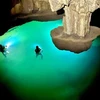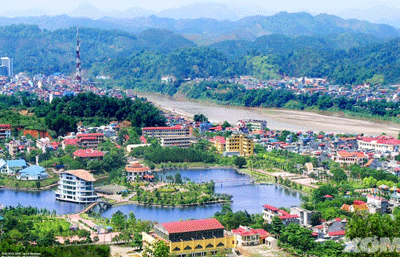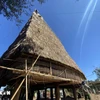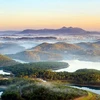 Although Nam Son cave, which is located 1,000 metres above the sea level, boasts stunning beauty, it has yet to become popular among trekkers. Visitors have to weave through the bamboo forest and walk the only path along the mountainside for some 45 minutes to reach the site. A sudden rain could make the path slippery and dangerous to the novice hiker compared to the variety of other terrain on the path. Nam Son cave, or Ton cave, was discovered in January 2004, but today it remains untouched. The cave was likely formed due to volcanic eruptions and the tectonics of limestone mountains with underground rivers that cause erosion. Formations arose from water droplets dripping limestone minerals for millions of years. (Photo: VietnamPlus)
Although Nam Son cave, which is located 1,000 metres above the sea level, boasts stunning beauty, it has yet to become popular among trekkers. Visitors have to weave through the bamboo forest and walk the only path along the mountainside for some 45 minutes to reach the site. A sudden rain could make the path slippery and dangerous to the novice hiker compared to the variety of other terrain on the path. Nam Son cave, or Ton cave, was discovered in January 2004, but today it remains untouched. The cave was likely formed due to volcanic eruptions and the tectonics of limestone mountains with underground rivers that cause erosion. Formations arose from water droplets dripping limestone minerals for millions of years. (Photo: VietnamPlus)  It takes visitors around 45 minutes to walk through a bamboo forest to reach national relic Nam Son cave. For some people, the desire to explore a cave is almost irresistible. It’s another world of traversing underground, full of potential wonders and possible mysteries waiting to be solved. Though Vietnam is renowned for its jaw-dropping cave systems, cave exploration is still new to most Vietnamese people. Actually, cave exploration in the country is stigmatised for the risk it bears, but professional trekkers believe that with the right equipment and training, the activity is not so dangerous. The sport can also be expensive at times because the gear needed to guarantee safety is not widely sold in Vietnam. (Photo: VietnamPlus)
It takes visitors around 45 minutes to walk through a bamboo forest to reach national relic Nam Son cave. For some people, the desire to explore a cave is almost irresistible. It’s another world of traversing underground, full of potential wonders and possible mysteries waiting to be solved. Though Vietnam is renowned for its jaw-dropping cave systems, cave exploration is still new to most Vietnamese people. Actually, cave exploration in the country is stigmatised for the risk it bears, but professional trekkers believe that with the right equipment and training, the activity is not so dangerous. The sport can also be expensive at times because the gear needed to guarantee safety is not widely sold in Vietnam. (Photo: VietnamPlus)  Vietnam is well-known for its breathtaking cave system, with the most famous one being Son Doong in the central province of Quang Binh. The cave has been recognised as the largest in the world by three international organisations including Guinness (based in the UK), the Association World Record (based in Hong Kong) and World Kings (based in the US and India). The cave is located in the heart of Phong Nha – Ke Bang National Park. It was discovered by a local in 1991 and was first explored in 2009 by the British Cave Research Association. It has been open to the public since 2013. The nine-kilometre-long cave system, which extends through a mountain, was honored as one of the most captivating caves on earth by National Geographic. (Photo: VietnamPlus)
Vietnam is well-known for its breathtaking cave system, with the most famous one being Son Doong in the central province of Quang Binh. The cave has been recognised as the largest in the world by three international organisations including Guinness (based in the UK), the Association World Record (based in Hong Kong) and World Kings (based in the US and India). The cave is located in the heart of Phong Nha – Ke Bang National Park. It was discovered by a local in 1991 and was first explored in 2009 by the British Cave Research Association. It has been open to the public since 2013. The nine-kilometre-long cave system, which extends through a mountain, was honored as one of the most captivating caves on earth by National Geographic. (Photo: VietnamPlus)  Although Nam Son is much smaller than the famed Son Doong cave, which was formed two to five million years ago, and is roughly 200 metres wide, it is worth a visit. According to Dinh Van Phuong (a resident in Do hamlet, Van Son commune), a safe guard at the cave, Nam Son cave is 1,000 metres above the sea level. It is located in Ton hamlet, Nam Son commune, Tan Lac district, about 25 kilometres to the south of the northern province of Hoa Binh. Nam Son cave, or Ton cave, was discovered in January 2004 but today it remains untouched. (Photo: VietnamPlus)
Although Nam Son is much smaller than the famed Son Doong cave, which was formed two to five million years ago, and is roughly 200 metres wide, it is worth a visit. According to Dinh Van Phuong (a resident in Do hamlet, Van Son commune), a safe guard at the cave, Nam Son cave is 1,000 metres above the sea level. It is located in Ton hamlet, Nam Son commune, Tan Lac district, about 25 kilometres to the south of the northern province of Hoa Binh. Nam Son cave, or Ton cave, was discovered in January 2004 but today it remains untouched. (Photo: VietnamPlus)  Nam Son Cave was recognised as a national relic site in 2008, four years after it was found. The cave is located in the buffer zone of the Cuc Phuong National Park, and Ngoc Son – Ngo Luong Natural Reserve. Established in 1962, Cuc Phuong is the first and largest nature reserve in Vietnam. The park is located around 120km southwest of Hanoi and nestled in the convergence of three provinces: Ninh Binh, Hoa Binh and Thanh Hoa. Covering an area of 25,000 hectares, the park is a typical tropical rainforest that is home to a diversified system of flora and fauna and contains several highly endangered species. (Photo: VietnamPlus)
Nam Son Cave was recognised as a national relic site in 2008, four years after it was found. The cave is located in the buffer zone of the Cuc Phuong National Park, and Ngoc Son – Ngo Luong Natural Reserve. Established in 1962, Cuc Phuong is the first and largest nature reserve in Vietnam. The park is located around 120km southwest of Hanoi and nestled in the convergence of three provinces: Ninh Binh, Hoa Binh and Thanh Hoa. Covering an area of 25,000 hectares, the park is a typical tropical rainforest that is home to a diversified system of flora and fauna and contains several highly endangered species. (Photo: VietnamPlus)  According to a local official, Nam Son cave was formed millions of years ago. However, it remains mysterious since the cave has not received any planning or development from the local authorities. Nam Son cave was likely formed due to volcanic eruptions and the tectonics of limestone mountains and underground rivers that caused erosion. Water droplets of limestone minerals dripped for millions of years, creating many beautiful stalactites and stalagmites. Throughout the cave ceiling and walls are beautifully shaped stalactites. The two sides of the entrance to the cave have beautifully shaped rocky embankments, a natural barrier that protects the interior of the cave. (Photo: VietnamPlus)
According to a local official, Nam Son cave was formed millions of years ago. However, it remains mysterious since the cave has not received any planning or development from the local authorities. Nam Son cave was likely formed due to volcanic eruptions and the tectonics of limestone mountains and underground rivers that caused erosion. Water droplets of limestone minerals dripped for millions of years, creating many beautiful stalactites and stalagmites. Throughout the cave ceiling and walls are beautifully shaped stalactites. The two sides of the entrance to the cave have beautifully shaped rocky embankments, a natural barrier that protects the interior of the cave. (Photo: VietnamPlus)  Local residents said they have been aware of the cave for a long time. However, the darkness of the cave’s interior makes it difficult to explore without the proper lighting and climbing equipment. A group of farmers that were working in the daytime heat decided to use the light to go inside the cave, hoping to find water to quench their thirst. In their search to quench their thirst, they found a large emerald lake inside the cave. The lake spans nearly 1,000 square metres and is a distinct feature of the Nam Son Cave that doesn’t exist in other sites. In the photo, years of water erosion forms yellow and white stalactites naturally forming many beautiful and mysterious shapes. (Photo: VietnamPlus)
Local residents said they have been aware of the cave for a long time. However, the darkness of the cave’s interior makes it difficult to explore without the proper lighting and climbing equipment. A group of farmers that were working in the daytime heat decided to use the light to go inside the cave, hoping to find water to quench their thirst. In their search to quench their thirst, they found a large emerald lake inside the cave. The lake spans nearly 1,000 square metres and is a distinct feature of the Nam Son Cave that doesn’t exist in other sites. In the photo, years of water erosion forms yellow and white stalactites naturally forming many beautiful and mysterious shapes. (Photo: VietnamPlus)  Scientists said Nam Son Cave, 445 metres in length, is one of the best discovered at the Ngoc Son – Ngo Luong Nature Reserve. Ngoc Son – Ngo Luong Nature Reserve (also named Ngoc Son – Tu Do), located southwest of Hanoi, is a real heaven and a fascinating destination for all nature lovers. The protected site is recommended for tourists who want to get out of the bustling cities and spend quality time in an exotic and natural setting. This area is in the northeast side of the limestone ranges stretching toward the northwest from Cuc Phuong National Park to Viet-Laos land border. The topography has characteristics of the limestone mountain areas, with steep and rocky terraces. Between the karsts are some flat valleys running toward the northwest and southeast. Its elevation ranges from 100m to 1.065m, with the average height of the limestone peak at 600m. (Photo: VietnamPlus)
Scientists said Nam Son Cave, 445 metres in length, is one of the best discovered at the Ngoc Son – Ngo Luong Nature Reserve. Ngoc Son – Ngo Luong Nature Reserve (also named Ngoc Son – Tu Do), located southwest of Hanoi, is a real heaven and a fascinating destination for all nature lovers. The protected site is recommended for tourists who want to get out of the bustling cities and spend quality time in an exotic and natural setting. This area is in the northeast side of the limestone ranges stretching toward the northwest from Cuc Phuong National Park to Viet-Laos land border. The topography has characteristics of the limestone mountain areas, with steep and rocky terraces. Between the karsts are some flat valleys running toward the northwest and southeast. Its elevation ranges from 100m to 1.065m, with the average height of the limestone peak at 600m. (Photo: VietnamPlus)  Stepping through the gate which is only one metre in height, visitors will be surprised as if they enter a new world. The cave has a dark and cool atmosphere. Stalactites and stalagmites have vivid shapes and seem to hold the feet in place. Sometimes they look like the curtains of a castle, sometimes like a silk strips hanging from the cliff. There are winding stone veins in the cave walls that look like they were installed by a painstaking and skilled craftsman. There are many stalactites like silk strips on the cave walls. Visitors can see water flowing from the mountain, forming small geysers along the cliffs. They are very unique, sometimes like a small waterfall, sometimes like the mouth of a large river. (Photo: VietnamPlus)
Stepping through the gate which is only one metre in height, visitors will be surprised as if they enter a new world. The cave has a dark and cool atmosphere. Stalactites and stalagmites have vivid shapes and seem to hold the feet in place. Sometimes they look like the curtains of a castle, sometimes like a silk strips hanging from the cliff. There are winding stone veins in the cave walls that look like they were installed by a painstaking and skilled craftsman. There are many stalactites like silk strips on the cave walls. Visitors can see water flowing from the mountain, forming small geysers along the cliffs. They are very unique, sometimes like a small waterfall, sometimes like the mouth of a large river. (Photo: VietnamPlus)  Visitors to Nam Son Cave are greeted with breathtaking scenes. There are a wide range of beautiful stalactites and stalagmites inside the cave. Nam Son cave was likely formed due to volcanic eruptions and the tectonics of limestone mountains and underground rivers that caused erosion. Water droplets of limestone minerals dripped for millions of years. Nam Son cave, 1,000 metres above sea level, is located in Ton hamlet, Nam Son commune, Tan Lac district, about 25 kilometres to the south of the northern province of Hoa Binh. Nam Son cave, or Ton cave, was discovered in January 2004 but today it remains relatively untouched as the government has yet to develop plans for the site. (Photo: VietnamPlus)
Visitors to Nam Son Cave are greeted with breathtaking scenes. There are a wide range of beautiful stalactites and stalagmites inside the cave. Nam Son cave was likely formed due to volcanic eruptions and the tectonics of limestone mountains and underground rivers that caused erosion. Water droplets of limestone minerals dripped for millions of years. Nam Son cave, 1,000 metres above sea level, is located in Ton hamlet, Nam Son commune, Tan Lac district, about 25 kilometres to the south of the northern province of Hoa Binh. Nam Son cave, or Ton cave, was discovered in January 2004 but today it remains relatively untouched as the government has yet to develop plans for the site. (Photo: VietnamPlus)  According to Bui Thanh Duong, Vice Chairman of the People’s Committee of Van Son commune, the local authorities are making every effort to preserve and promote values of this excellent cave since it could play an important role in tourism development of Tan Lac district. As one of the four ancient ethnic Muong regions and the cradle of the famous Hoa Binh culture, the unique culture and peaceful landscape of Tan Lac District is an important resource to help the district develop sustainable tourism. Tan Lac is an ideal destination for those who both love Muong culture and want to enjoy a peaceful life away from the hustle of cities. (Photo: VietnamPlus)
According to Bui Thanh Duong, Vice Chairman of the People’s Committee of Van Son commune, the local authorities are making every effort to preserve and promote values of this excellent cave since it could play an important role in tourism development of Tan Lac district. As one of the four ancient ethnic Muong regions and the cradle of the famous Hoa Binh culture, the unique culture and peaceful landscape of Tan Lac District is an important resource to help the district develop sustainable tourism. Tan Lac is an ideal destination for those who both love Muong culture and want to enjoy a peaceful life away from the hustle of cities. (Photo: VietnamPlus)  Duong said the local residents have been aware of the cave for a long time. However, the darkness of the cave interior makes it difficult to explore without the proper lighting and climbing equipment. A group of farmers that were working in the daytime heat decided to use the light to go inside the cave, hoping to find water to quench their thirst. In their search to quench their thirst, they found a large emerald lake inside the cave. The lake spans nearly 1,000 square metres and is a distinct feature of the Nam Son Cave that doesn’t exist in other sites. In the photo, the water erosion process forms yellow and white stalactites with many beautiful and mysterious shapes. (Photo: VietnamPlus)
Duong said the local residents have been aware of the cave for a long time. However, the darkness of the cave interior makes it difficult to explore without the proper lighting and climbing equipment. A group of farmers that were working in the daytime heat decided to use the light to go inside the cave, hoping to find water to quench their thirst. In their search to quench their thirst, they found a large emerald lake inside the cave. The lake spans nearly 1,000 square metres and is a distinct feature of the Nam Son Cave that doesn’t exist in other sites. In the photo, the water erosion process forms yellow and white stalactites with many beautiful and mysterious shapes. (Photo: VietnamPlus)  Nam Son cave has the distinct features of staying warm in the winter and cool in the summer. Therefore, visitors can explore the cave anytime of the year. It takes visitors around 45 minutes to walk through a bamboo forest to reach the national relic Nam Son cave. For some people, the desire to explore a cave is almost irresistible. It’s another world of traversing underground, full of potential wonders and possible mysteries waiting to be solved. Nam Son cave, or Ton cave, was discovered in January 2004 but today it remains untouched. The cave was likely formed due to volcanic eruptions and the tectonics of limestone mountains. (Photo: VietnamPlus)
Nam Son cave has the distinct features of staying warm in the winter and cool in the summer. Therefore, visitors can explore the cave anytime of the year. It takes visitors around 45 minutes to walk through a bamboo forest to reach the national relic Nam Son cave. For some people, the desire to explore a cave is almost irresistible. It’s another world of traversing underground, full of potential wonders and possible mysteries waiting to be solved. Nam Son cave, or Ton cave, was discovered in January 2004 but today it remains untouched. The cave was likely formed due to volcanic eruptions and the tectonics of limestone mountains. (Photo: VietnamPlus)  According to geologists, Nam Son cave was formed some 250 million years ago, and houses a kaleidoscope of stalactites and stalagmites in various shapes. Stalactites and stalagmites with vivid shapes seemed to hold the feet in place. Sometimes they look like the curtains of a castle, sometimes like a silk strip hanging from the cliff. There are winding stone veins that look as if they have been painstakingly installed by skilled craftsmen. There are many stalactites like silk threads on the cave walls. Located in Nam Son commune, Tan Lac district, the northern province of Hoa Binh, national relic Nam Son cave beckons adventurous travellers to conquer its pristine and mysterious beauty. (Photo: VietnamPlus)
According to geologists, Nam Son cave was formed some 250 million years ago, and houses a kaleidoscope of stalactites and stalagmites in various shapes. Stalactites and stalagmites with vivid shapes seemed to hold the feet in place. Sometimes they look like the curtains of a castle, sometimes like a silk strip hanging from the cliff. There are winding stone veins that look as if they have been painstakingly installed by skilled craftsmen. There are many stalactites like silk threads on the cave walls. Located in Nam Son commune, Tan Lac district, the northern province of Hoa Binh, national relic Nam Son cave beckons adventurous travellers to conquer its pristine and mysterious beauty. (Photo: VietnamPlus)  Scientists said Nam Son Cave, 445 metres in length, is one of the best discovered at the Ngoc Son – Ngo Luong Nature Reserve. Although Nam Son was recognized as a national relic site, and investment was channeled to build road into the cave, it is necessary for visitors to make meticulous preparations. Cave exploring in Vietnam is stigmatized for the risks it bears, but professional trekkers believe only carelessness can make this sport dangerous. The sport can also be expensive at times because the gear needed to guarantee safety is not yet widely sold in Vietnam. The fundamental gear to enter caves includes a helmet, flashlight, climbing clothes, and proper climbing footwear for the avid explorer. (Photo: VietnamPlus)
Scientists said Nam Son Cave, 445 metres in length, is one of the best discovered at the Ngoc Son – Ngo Luong Nature Reserve. Although Nam Son was recognized as a national relic site, and investment was channeled to build road into the cave, it is necessary for visitors to make meticulous preparations. Cave exploring in Vietnam is stigmatized for the risks it bears, but professional trekkers believe only carelessness can make this sport dangerous. The sport can also be expensive at times because the gear needed to guarantee safety is not yet widely sold in Vietnam. The fundamental gear to enter caves includes a helmet, flashlight, climbing clothes, and proper climbing footwear for the avid explorer. (Photo: VietnamPlus)  According to a local official, Nam Son, 1,000 metres above sea level, cave was formed millions of years ago. However, it remains mysterious since the cave has not received any planning from the local authority. Nam Son cave was likely formed due to volcanic eruptions and the tectonics of limestone mountains and underground rivers to cause erosion. Water droplets of limestone minerals dripped for millions of years, creating many beautiful stalactites and stalagmites. Throughout the cave ceiling and cave walls are beautifully shaped stalactites. The two sides of the entrance to the cave also have beautiful rocky embankments that guard the naturally-formed entrance. (Photo: VietnamPlus)
According to a local official, Nam Son, 1,000 metres above sea level, cave was formed millions of years ago. However, it remains mysterious since the cave has not received any planning from the local authority. Nam Son cave was likely formed due to volcanic eruptions and the tectonics of limestone mountains and underground rivers to cause erosion. Water droplets of limestone minerals dripped for millions of years, creating many beautiful stalactites and stalagmites. Throughout the cave ceiling and cave walls are beautifully shaped stalactites. The two sides of the entrance to the cave also have beautiful rocky embankments that guard the naturally-formed entrance. (Photo: VietnamPlus)  Experienced trekkers find the most attractive thing about the Nam Son cave is the unflawed beauty of darkness and quietness in its unexplored chambers. Vietnam has a wide range of stunning caves, but cave exploration remains new to most Vietnamese. From an exploration perspective, there are two types of caves. The first is those that are mostly flat and not too difficult to traverse. Caves in the second category usually require ropes and climbing equipment and contain many deep holes, according to an experienced explorer. An exploration trip usually lasts from eight to ten hours, while in many cases it can take up to three days. (Photo: VietnamPlus)
Experienced trekkers find the most attractive thing about the Nam Son cave is the unflawed beauty of darkness and quietness in its unexplored chambers. Vietnam has a wide range of stunning caves, but cave exploration remains new to most Vietnamese. From an exploration perspective, there are two types of caves. The first is those that are mostly flat and not too difficult to traverse. Caves in the second category usually require ropes and climbing equipment and contain many deep holes, according to an experienced explorer. An exploration trip usually lasts from eight to ten hours, while in many cases it can take up to three days. (Photo: VietnamPlus)  Stepping through the gate which is only one metre in height, visitors set foot in a completely different world. The cave has a cool and mysterious interior. Nam Son cave, 1,000 metres above the sea level, is located in Ton hamlet, Nam Son commune, Tan Lac district, about 25 kilometres to the south of the northern province of Hoa Binh. Nam Son cave, or Ton cave, was discovered in January 2004 but today it remains untouched. There are many stalactites like silk threads on the cave walls. Visitors can see water flowing from the mountain, forming small geysers along the cliffs. (Photo: VietnamPlus)
Stepping through the gate which is only one metre in height, visitors set foot in a completely different world. The cave has a cool and mysterious interior. Nam Son cave, 1,000 metres above the sea level, is located in Ton hamlet, Nam Son commune, Tan Lac district, about 25 kilometres to the south of the northern province of Hoa Binh. Nam Son cave, or Ton cave, was discovered in January 2004 but today it remains untouched. There are many stalactites like silk threads on the cave walls. Visitors can see water flowing from the mountain, forming small geysers along the cliffs. (Photo: VietnamPlus)  According to Bui Thanh Duong, Vice Chairman of the People’s Committee of Van Son commune, the local authorities are making every effort to preserve and promote the environmental value of this excellent cave since it could play an important role in tourism development of Tan Lac district. As one of the four ancient ethnic Muong regions and the cradle of the famous Hoa Binh culture, the unique culture and peaceful landscape of Tan Lac District is an important resource to help the district develop sustainable tourism. Tan Lac is an ideal destination for those who both love Muong culture and want to enjoy a peaceful life away from the hustle and bustle of cities. (Photo: VietnamPlus)
According to Bui Thanh Duong, Vice Chairman of the People’s Committee of Van Son commune, the local authorities are making every effort to preserve and promote the environmental value of this excellent cave since it could play an important role in tourism development of Tan Lac district. As one of the four ancient ethnic Muong regions and the cradle of the famous Hoa Binh culture, the unique culture and peaceful landscape of Tan Lac District is an important resource to help the district develop sustainable tourism. Tan Lac is an ideal destination for those who both love Muong culture and want to enjoy a peaceful life away from the hustle and bustle of cities. (Photo: VietnamPlus)  In the time to come, local authorities will channel investments to upgrade and add more facilities to serve visitors to Nam Son national relic site. The move will help diversify tourism products in Tan Lac district. Tan Lac is an ideal destination for those who both love Muong culture and want to enjoy a peaceful life away from the hustle and bustle of cities. Located at the gateway of the northwest region, about 100km from Hanoi, the district has a large, fresh and airy space with preserved traditional values such as Mo Muong -- a popular ritual ceremony which has become the unique cultural heritage of the Muong ethnicity. Mường gongs are also part of the local heritage, as are many unique traditional handicraft products such as hand-loom weaving, knitting, can wine (rice wine stored in a big jar and drunk with long bamboo stems) and folk festivals. (Photo: VietnamPlus)
In the time to come, local authorities will channel investments to upgrade and add more facilities to serve visitors to Nam Son national relic site. The move will help diversify tourism products in Tan Lac district. Tan Lac is an ideal destination for those who both love Muong culture and want to enjoy a peaceful life away from the hustle and bustle of cities. Located at the gateway of the northwest region, about 100km from Hanoi, the district has a large, fresh and airy space with preserved traditional values such as Mo Muong -- a popular ritual ceremony which has become the unique cultural heritage of the Muong ethnicity. Mường gongs are also part of the local heritage, as are many unique traditional handicraft products such as hand-loom weaving, knitting, can wine (rice wine stored in a big jar and drunk with long bamboo stems) and folk festivals. (Photo: VietnamPlus)  Although Nam Son cave, 1,000 metres above the sea level, boasts stunning beauty, it has yet to become popular among trekkers. Tan Lac district will make further investment in the relic site, hoping to lure more visitors to the locality. The highland area of Tan Lac includes Van Son, Ngo Luong and Quyet Chien communes adjacent to the primeval forest area. On hot summer days, the weather here is very cool. The people here are honest, kind and still preserve the ancient Muong culture. Overcoming the mists on the winding road, the valley of Van Son, or Lung Van, gradually appears with natural landscapes and a fresh, cool climate. (Photo: VietnamPlus)
Although Nam Son cave, 1,000 metres above the sea level, boasts stunning beauty, it has yet to become popular among trekkers. Tan Lac district will make further investment in the relic site, hoping to lure more visitors to the locality. The highland area of Tan Lac includes Van Son, Ngo Luong and Quyet Chien communes adjacent to the primeval forest area. On hot summer days, the weather here is very cool. The people here are honest, kind and still preserve the ancient Muong culture. Overcoming the mists on the winding road, the valley of Van Son, or Lung Van, gradually appears with natural landscapes and a fresh, cool climate. (Photo: VietnamPlus)  The darkness of the caves makes them difficult to explore without proper lighting and climbing equipment. A group of farmers that were working in the daytime heat decided to use the light to go inside the cave, hoping to find water to quench their thirst. In their search to quench their thirst, they found a large emerald lake inside the cave. The lake spans nearly 1,000 square metres and is a distinct feature of the Nam Son Cave that doesn’t exist in other sites. Besides Nam Son cave, the valley of Van Son, or Lung Van, is another destination that visitors should not miss if they come to Tan Lac district. Located at an altitude of 1,200m above sea level, surrounded by Trau, Co and Tien mountains, Lung Van is surrounded by clouds all year round. It is also known as the "valley of clouds". (Photo: VietnamPlus)
The darkness of the caves makes them difficult to explore without proper lighting and climbing equipment. A group of farmers that were working in the daytime heat decided to use the light to go inside the cave, hoping to find water to quench their thirst. In their search to quench their thirst, they found a large emerald lake inside the cave. The lake spans nearly 1,000 square metres and is a distinct feature of the Nam Son Cave that doesn’t exist in other sites. Besides Nam Son cave, the valley of Van Son, or Lung Van, is another destination that visitors should not miss if they come to Tan Lac district. Located at an altitude of 1,200m above sea level, surrounded by Trau, Co and Tien mountains, Lung Van is surrounded by clouds all year round. It is also known as the "valley of clouds". (Photo: VietnamPlus)  Although Nam Son is much smaller than the famed Son Doong Cave, which was formed two to five million years ago, and is roughly 200 metres wide, it is worth a visit. According to Dinh Van Phuong (a resident in Do hamlet, Van Son commune), a safe guard at the cave, Nam Son cave is 1,000 metres above the sea level. It is located in Ton hamlet, Nam Son commune, Tan Lac district, about 25 kilometres to the south of the northern province of Hoa Binh. Nam Son cave, or Ton cave, was discovered in January 2004 but today it remains untouched. (Photo: VietnamPlus)
Although Nam Son is much smaller than the famed Son Doong Cave, which was formed two to five million years ago, and is roughly 200 metres wide, it is worth a visit. According to Dinh Van Phuong (a resident in Do hamlet, Van Son commune), a safe guard at the cave, Nam Son cave is 1,000 metres above the sea level. It is located in Ton hamlet, Nam Son commune, Tan Lac district, about 25 kilometres to the south of the northern province of Hoa Binh. Nam Son cave, or Ton cave, was discovered in January 2004 but today it remains untouched. (Photo: VietnamPlus)  Vietnam is well-known for its breathtaking cave system, with the most famous one being Son Doong in the central province of Quang Binh. Son Doong Cave, the world’s largest cave in Quang Binh Province, has been listed among “20 record-breaking natural wonders” by the US news site Insider. Son Doong Cave is part of the Phong Nha-Ke Bang National Park, which is estimated to be between 400 million and 450 million years old. The nine-kilometre-long cave was declared the world’s largest and opened to tourists in 2013, four years after members of the British Cave Research Association finished their exploration. Registration for Son Doong tours is organised between June and August this year by Oxalis, the only private company licensed to explore and conduct tours of Son Doong. (Photo: VietnamPlus)
Vietnam is well-known for its breathtaking cave system, with the most famous one being Son Doong in the central province of Quang Binh. Son Doong Cave, the world’s largest cave in Quang Binh Province, has been listed among “20 record-breaking natural wonders” by the US news site Insider. Son Doong Cave is part of the Phong Nha-Ke Bang National Park, which is estimated to be between 400 million and 450 million years old. The nine-kilometre-long cave was declared the world’s largest and opened to tourists in 2013, four years after members of the British Cave Research Association finished their exploration. Registration for Son Doong tours is organised between June and August this year by Oxalis, the only private company licensed to explore and conduct tours of Son Doong. (Photo: VietnamPlus)  Local residents said they have been aware of the cave for a long time. However, the darkness of the cave interior makes it difficult to explore without the proper lighting and climbing equipment. A group of farmers that were working in the daytime heat decided to use the light to go inside the cave, hoping to find water to quench their thirst. In their search to quench their thirst, they found a large emerald lake inside the cave. The lake spans nearly 1,000 square metres and is a distinct feature of the Nam Son Cave that doesn’t exist in other sites. In the photo, the water erosion process forms many beautiful and mysterious shapes with the yellow and white stalactites. (Photo: VietnamPlus)
Local residents said they have been aware of the cave for a long time. However, the darkness of the cave interior makes it difficult to explore without the proper lighting and climbing equipment. A group of farmers that were working in the daytime heat decided to use the light to go inside the cave, hoping to find water to quench their thirst. In their search to quench their thirst, they found a large emerald lake inside the cave. The lake spans nearly 1,000 square metres and is a distinct feature of the Nam Son Cave that doesn’t exist in other sites. In the photo, the water erosion process forms many beautiful and mysterious shapes with the yellow and white stalactites. (Photo: VietnamPlus)  Experienced trekkers find the most attractive thing about Nam Son cave is the unflawed beauty of darkness and quietness of the unexplored chambers. It is the lake spanning nearly 1,000 square metres that makes Nam Son Cave unique. Nam Son cave was likely formed due to volcanic eruptions and the tectonics of limestone mountains and underground rivers that caused erosion. Water droplets of limestone minerals dripped for millions of years, creating many beautiful stalactites and stalagmites. Over the cave ceiling and cave walls are beautifully shaped stalactites. The two sides of the entrance to the cave also have rocky embankments that form a beautiful yet natural aspect to the site. (Photo: VietnamPlus)
Experienced trekkers find the most attractive thing about Nam Son cave is the unflawed beauty of darkness and quietness of the unexplored chambers. It is the lake spanning nearly 1,000 square metres that makes Nam Son Cave unique. Nam Son cave was likely formed due to volcanic eruptions and the tectonics of limestone mountains and underground rivers that caused erosion. Water droplets of limestone minerals dripped for millions of years, creating many beautiful stalactites and stalagmites. Over the cave ceiling and cave walls are beautifully shaped stalactites. The two sides of the entrance to the cave also have rocky embankments that form a beautiful yet natural aspect to the site. (Photo: VietnamPlus)  Going down the cave some 40 metres from the cave entrance, visitors can hear the sound of water running and wind blowing gently into the cave. Here you can see how stunning the landscape here is. Vietnam is well-known for its marvelous caves, and the Tu Lan cave system, considered as one of the country’s most diverse subterranean kingdoms, has become a newly-emerging destination for backpackers. Located 70km from the Phong Nha-Ke Bang National Park and next to Tan Hoa commune of Minh Hoa district, Quang Binh province, the Tu Lan cave system is hidden among meadows, corn and peanut fields. To discover this cave system, tourists will go across meadows, green valleys and jungles, conquering superb mountain slopes and swimming through underground rivers. (Photo: VietnamPlus)
Going down the cave some 40 metres from the cave entrance, visitors can hear the sound of water running and wind blowing gently into the cave. Here you can see how stunning the landscape here is. Vietnam is well-known for its marvelous caves, and the Tu Lan cave system, considered as one of the country’s most diverse subterranean kingdoms, has become a newly-emerging destination for backpackers. Located 70km from the Phong Nha-Ke Bang National Park and next to Tan Hoa commune of Minh Hoa district, Quang Binh province, the Tu Lan cave system is hidden among meadows, corn and peanut fields. To discover this cave system, tourists will go across meadows, green valleys and jungles, conquering superb mountain slopes and swimming through underground rivers. (Photo: VietnamPlus)  The stalactites inside Nam Son cave are an amazing sight that awes visitors. Nam Son Cave was recognised as a national relic site in 2008, four years after it was found. The cave is located in the buffer zone of the Cuc Phuong National Park, and Ngoc Son – Ngo Luong Natural Reserve. Established in 1962, Cuc Phuong is the first and largest nature reserve in Vietnam. The park is located around 120km southwest of Hanoi and nestled in the convergence of three provinces: Ninh Binh, Hoa Binh and Thanh Hoa. Covering an area of 25,000 hectares, the park is a typical tropical rainforest that is home to a diversified system of flora and fauna and contains several highly endangered species. (Photo: VietnamPlus)
The stalactites inside Nam Son cave are an amazing sight that awes visitors. Nam Son Cave was recognised as a national relic site in 2008, four years after it was found. The cave is located in the buffer zone of the Cuc Phuong National Park, and Ngoc Son – Ngo Luong Natural Reserve. Established in 1962, Cuc Phuong is the first and largest nature reserve in Vietnam. The park is located around 120km southwest of Hanoi and nestled in the convergence of three provinces: Ninh Binh, Hoa Binh and Thanh Hoa. Covering an area of 25,000 hectares, the park is a typical tropical rainforest that is home to a diversified system of flora and fauna and contains several highly endangered species. (Photo: VietnamPlus)  The dangling stalactites are part of the allure for visitors to Nam Son cave in Nam Son commune, Tan Lac district, Hoa Binh province. Trekkers have to weave through the bamboo forest and walk on the only path along the mountainside for some 45 minutes to hike in to the cave. A sudden rain could make the path slippery, a little bit more dangerous than usual when walking on the diverse terrain. Nam Son cave, or Ton cave, was discovered in January 2004 but today it remains untouched. Hoa Binh province will make investment in Nam Son cave relic site, making it a standout tourism product in Tan Lac district in the coming time. (Photo: VietnamPlus)
The dangling stalactites are part of the allure for visitors to Nam Son cave in Nam Son commune, Tan Lac district, Hoa Binh province. Trekkers have to weave through the bamboo forest and walk on the only path along the mountainside for some 45 minutes to hike in to the cave. A sudden rain could make the path slippery, a little bit more dangerous than usual when walking on the diverse terrain. Nam Son cave, or Ton cave, was discovered in January 2004 but today it remains untouched. Hoa Binh province will make investment in Nam Son cave relic site, making it a standout tourism product in Tan Lac district in the coming time. (Photo: VietnamPlus)  Nam Son cave’s stunning beauty is shaped by its special dark and cool interior and a large emerald lake. Natural splendor awaits those who enter inside the cave. Nam Son Cave was recognized as a national relic site in 2008, four years after it was found. The cave is located in the buffer zone of the Cuc Phuong National Park, and Ngoc Son – Ngo Luong Natural Reserve. Vietnam is renowned for its jaw-dropping cave system. Cave exploration is still new to most Vietnamese people. Actually, cave exploring in the country is stigmatised for the risk it bears, but professional trekkers believe that with the right equipment and training, the exploration of the cave system is not dangerous. (Photo: VietnamPlus)
Nam Son cave’s stunning beauty is shaped by its special dark and cool interior and a large emerald lake. Natural splendor awaits those who enter inside the cave. Nam Son Cave was recognized as a national relic site in 2008, four years after it was found. The cave is located in the buffer zone of the Cuc Phuong National Park, and Ngoc Son – Ngo Luong Natural Reserve. Vietnam is renowned for its jaw-dropping cave system. Cave exploration is still new to most Vietnamese people. Actually, cave exploring in the country is stigmatised for the risk it bears, but professional trekkers believe that with the right equipment and training, the exploration of the cave system is not dangerous. (Photo: VietnamPlus) VNA



















